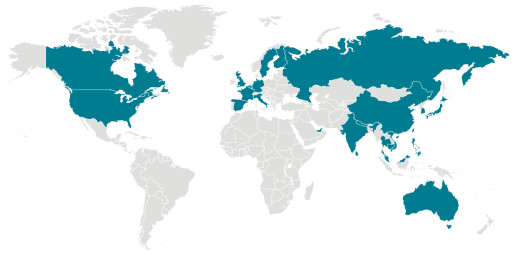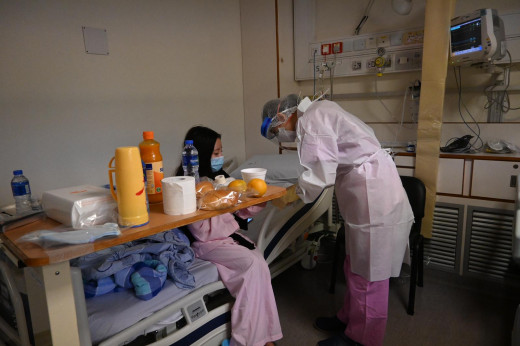WHO Declares Global Health Emergency: Should You Be Worried About the Coronavirus?
The 2019 Corona Virus Began in Wuhan, China

What is the Corona virus?
The COVID-19 (or 2019-nCoV as it was called earlier), also known as the Wuhan Coronavirus, is a strand of the Coronavirus family. These are respiratory illnesses and typically resemble the common cold. Coronaviruses are fairly common among humans and those affected typically experience rather mild symptoms. Coronaviruses, however, can also cause more serious illnesses such as pneumonia and bronchitis.
Coronaviruses tend to affect animals all over the world, but from what we know, only a few of the strands can be passed on to humans. The recent Wuhan Coronavirus, along with the severe acute respiratory syndrome coronavirus (SARS-Cov) from the previous decade, are two strands that do spread from animals to humans and both of these cause more severe symptoms.
The Huanan Seafood Market in Wuhan

Where did it Originate?
The novel Coronavirus is believed to have originated at the Huanan seafood market, located in Wuhan, China. Experts have confirmed that the first human cases of the virus were people that had visited the local seafood and animal market. The first human case was confirmed on December 31, 2019 and researchers believe that the virus got passed from an animal to infect its first human victim.
Some researchers believe that this strand of the coronavirus could have originated in bats, after comparing it with two other closely related coronaviruses that were first spotted in bats. These two viruses share 88% of their genetic code with the COVID-19.
If we were to base our conclusions on these results alone, we could confirm that the Wuhan Coronavirus likely originated in bats. However, it is also known that bats were not sold at the Wuhan seafood market, which has since closed.
Other studies suggest that this particular strand of the virus got passed to human from snakes, which were in fact sold at the market. This assumption, however, has raised criticism, since experts are unsure of whether snakes can get infected with coronaviruses or not.
What we do know for sure so far is that the first human to get affected by the COVID-19 contracted the disease in the Chinese city of Wuhan and that the first human case was an animal-to-human transmission.
No Confirmed Cases in Africa or South America yet

From the First Human Infection to now
Dec. 31, 2019 — The first case of the Coronavirus is recorded in Wuhan City, Hubei Province, China. At the time, the case is assumed to be pneumonia, with no link to the Coronavirus.
Jan. 1 — The Huanan seafood market is closed in Wuhan, as it is suspected to be the origin of the unknown disease. Some of the victims claimed to have been vendors at the seafood market.
Jan. 3 — Chinese officials report that there are over 40 people affected by the 'mystery disease'.
Jan. 7 — It is identified that a new coronavirus is the cause of the outbreak. Authorities believe that the impact of the new coronavirus will be similar to those caused by SARS and MERS, both of which were also coronaviruses.
Jan. 9 — The COVID-19 claims its first human life. The victim was a 61-year-old man in Wuhan.
Jan. 12 — Chinese authorities share the genetic code of the novel coronavirus. This will make it easier to diagnose and trace potential victims.
Jan. 13 — First COVID-19 case outside of China. A 61-year-old woman was diagnosed in Thailand. She is from Wuhan, but did not visit the Huanan market.
Jan. 15 — Second death caused by the COVID-19 reported in China.
Jan. 16 — The coronavirus spreads to Japan. The patient is a Chinese man in his 30s, but did not visit the seafood market in Wuhan.
Jan. 18-19 — Spike in COVID-19 cases in China. One confirmed case in Shenzhen and 2 in Beijing. There are now a total of 204 confirmed cases and 3 deaths linked to the virus.
Jan. 20 — First COVID-19 case in South Korea.
Jan. 21 — First COVID-19 human-to-human is confirmed by WHO. A total of 222 confirmed cases and four deaths. Some health workers that had contact with coronavirus patients also got infected.
Jan. 22 — WHO has yet to declare the 2019 Coronavirus outbreak as an international public health emergency. 580 total confirmed cases, including 17 deaths, in the Hubei Province.
Jan. 23 — The COVID-19 is spreading fast. Wuhan goes into lockdown and shuts down public transportation, airport and railway stations. Ezhou goes into lockdown as well and Huanggang announces plans to go into lockdown. Lunar New Year festivities are canceled in Beijing. The virus spreads to Singapore (1 case) and Vietnam (2 cases)
Jan. 24 — The virus spreads to the USA and Nepal. There are now 830 confirmed cases, 177 severe cases and 2Japan and U.S. each confirm second COVID-19 cases, while Nepal confirms the first case of 2019-nCoV in the country. Total confirmed cases in China rise to 1287 , with 237 in severe condition and 41 deaths.
Jan. 25 — The COVID-19 spreads to Australia, France, Malaysia and Canada. Hong Kong suspends flights to and from Wuhan.
Jan. 26 — 80 people have died from the COVID-19 so far. Global cure research is underway. Chinese scientists begin developing a vaccine against the novel Coronavirus.
Jan. 27 — The Bill & Melinda Gates Foundation donates $10 million to aid with the outbreak response in China, and screening and outbreak preparedness in Africa. The virus spreads to Cambodia, Germany, and Sri Lanka.There are a total of 4580 cases globally.
Jan. 28 — China agrees with WHO's proposal to send in international experts to further aid with response efforts. The disease has yet to spread to Africa. There are already over 6 000 confirmed cases in the world.
Jan. 29 — First COVID-19 cases confirmed in UAE and Finland. Several countries prepare evacuations for their citizens still in Wuhan. Numerous airlines suspend flights to and from China.
There is progress in relation to cure research efforts: the 2019-nCoV has been successfully grown in an Australian laboratory. Alibaba founder Jack Ma donates $14.4 million to aid research efforts.
Jan. 30 — WHO declares the 2019-nCoV outbreak a public health emergency of international concern. The Philippines and India report their first cases.
How Many People are Infected?
Although China and other countries are reporting new 2019-nCoV cases on a daily basis, no one knows how many people really are infected at the epicenter of the outbreak.
Around 9782 cases have been officially confirmed by Chinese authorities, with over half of them being in the Hubei province.
Globally, there have already been nearly 10 000 infections.
The virus has so far claimed the lives of 213 people. All of the deaths occurred in China.
South America and Africa have not reported any cases as of yet.
Updates can be found here.
However, unofficial sources claim that there have been over 100 000 infections so far. People are worried that Chinese authorities may be withholding the actual numbers of those infected, just like they did with the SARS at the beginning of the century.
Isolation for the Infected

Who is at Risk?
It is believed that the COVID-19 spreads as easily as the common cold, however, some cases may be more severe than others.
Those with compromised immune systems or already recovering from another illness are at a greater risk of becoming infected with a severe case of the novel Coronavirus. The elderly are also at a higher risk of being impacted by the coronavirus. Over half of the confirmed cases so far were patients over the age of 60 and the average patient age is 59.
The majority of the cases so far have been those who have either visited the Huanan seafood market or have been to Wuhan in the past month or so. However, human-to-human transmission has been reported as well and some of those who got infected with the COVID-19 have not been to China.
What are the Symptoms?
In its early stages/mild cases, the novel Coronavirus can be confused with the common cold, as both diseases share common symptoms.
The symptoms, of course, vary from patient to patient, but commonly reported symptoms include:
-
fever;
- difficulty breathing;
- cough;
- shortness of breath;
However, in some of the more severe cases, the symptoms of the early stages of the disease have progressed to organ failure and shortly after, death.
In some people, the symptoms progressed to organ failure and death.

Global Health Emergency Declared
On Thursday, January 30, Tedros Adhanom Ghebreyesus, Director-General of WHO declared the COVID-19 a global health emergency. This is only the sixth time the WHO uses declares a global health emergency, a distinction which has been around since 2005.
WHO hopes that by raising awareness about the new coronavirus, countries can become more prepared to step up precautions taken to help prevent the virus from spreading uncontrollably. This declaration also urges countries with weaker healthcare systems to prepare themselves for potential future cases. Countries in South America, Latin America and Africa have not reported any cases so far, but it may only be a matter of time.
Should you be Concerned?
Despite the COVID-19 outbreak being declared a global health emergency, the risk of infection is still very low for the majority of the global population.
Normal precautions should be taken, as those you would take when protecting yourself from the flu. Cover your nose and mouth when you sneeze or cough, wash your hands with warm water and soap and avoid traveling/being in close contact with people if you experience any flu-like symptoms.
Those currently in Wuhan or in other parts of the Hubei province are at the greatest risk of contracting the virus due to the number of those already infected in the region and overcrowding at hospitals.
Global case numbers are still relatively low, so the average person outside of China who has not been to China recently is at a very low risk for infection. However, the incubation period of the COVID-19 is reported to be up to 14 days after first contact of the virus. This means that despite there being only a handful of cases in some countries, more could be yet to come.
Protect Yourself and Your Loved Ones
The COVID-19 is spreading fast, so extra precautions must be taken.
Avoid all non-essential travel to China, especially to the Hubei province. Health organizations also advise avoiding crowded places, especially in regions where a significant number of cases have already been reported.
Since the first COVID-19 cases are linked to animal to human transmission, people are advised to avoid animal and seafood markets, including dead and live animals and raw meat.
A number of people are beginning to wear face masks to protect themselves from the virus, but experts claim that this may not be enough.The virus is not only transmitted through the air, but also by direct contact. This means that you can touch a contaminated surface and later another part of your body or your food and infect yourself with the COVID-19 even with a mask on.
If you do feel sick, be sure to contact a doctor right away. It may be the common cold or it may be the early stages of the potentially fatal novel coronavirus.
© 2020 Emilia








